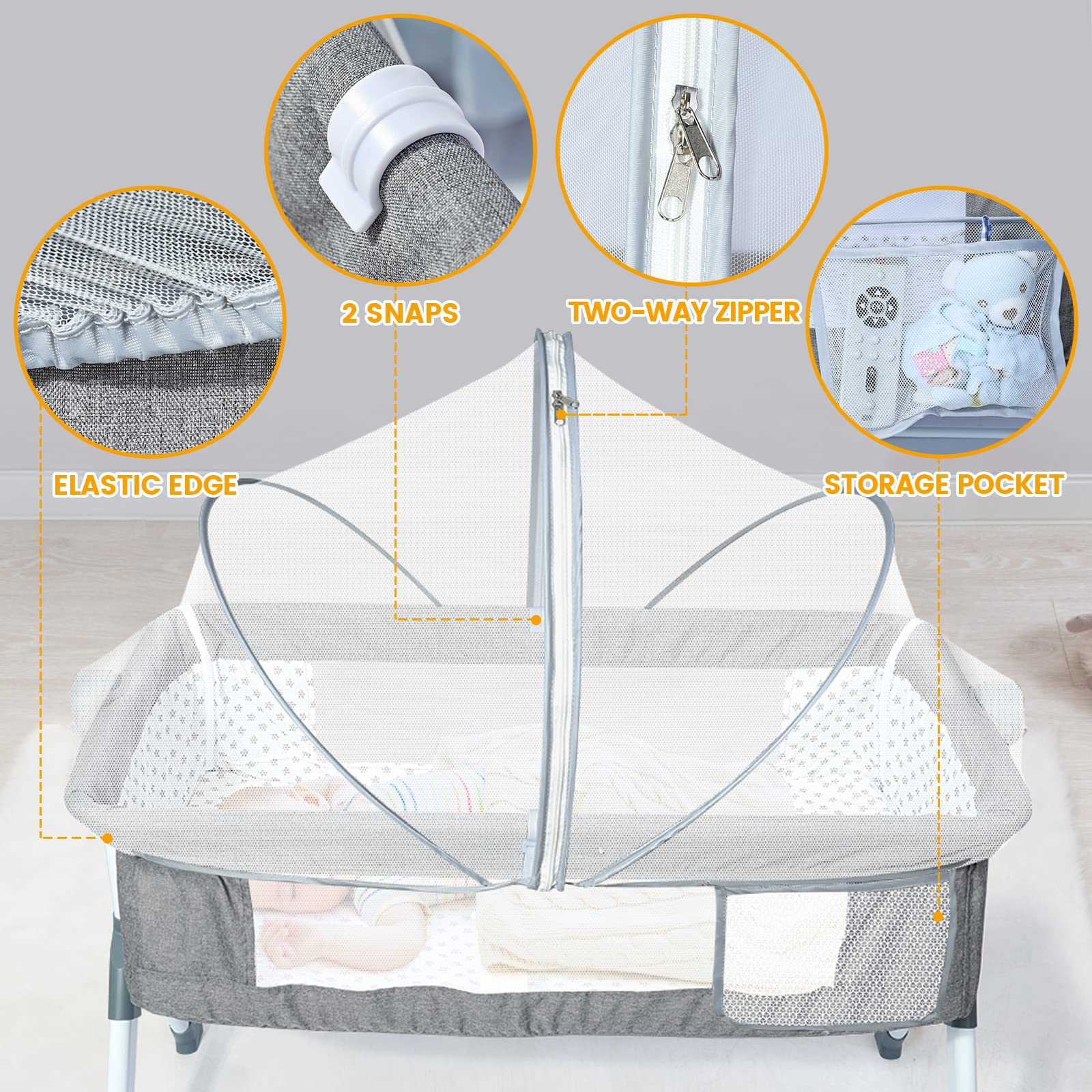



First, consider placing a breathable net or mesh cover over the crib. This barrier allows air circulation while deterring curious paws from entering. Make sure it’s securely fastened to avoid any escape routes.
Next, utilize scents that are unappealing to most felines. Citrus peels, vinegar, or commercial pet deterrent sprays can be effective. Spraying or placing these items around the crib area may discourage unwanted visits.
Creating a designated area for your furry friend can also help. Providing a cozy bed or a scratching post nearby gives them an alternative space, reducing their desire to invade the crib.
Regularly engaging in playtime can redirect their energy. Incorporate toys that stimulate physical activity, helping to tire them out and lessen the likelihood of them seeking out the crib for a nap.
Finally, consider using a motion-activated deterrent. Devices that emit a harmless burst of air or sound can startle and teach them that the crib is off-limits.
Utilizing Physical Barriers to Prevent Access

Install a sturdy, fitted cover over the crib to deter any attempts to sneak in. This could be a breathable mesh or a solid fabric that securely attaches to the frame. Make sure it is taut and difficult to dislodge.
Consider a Baby Gate
A baby gate can serve as a simple yet effective barricade. Position it in the doorway of the nursery to restrict entry while allowing visibility. Opt for a gate that is tall enough to deter jumping.
Alternative Furniture Placement

Rearranging furniture can also create barriers. Place a dresser or other large piece near the crib to obstruct direct access. This makes it less appealing to attempt a climb or jump into the sleeping area.
For more tips on managing nighttime disturbances with your furry companions, check out how to stop cats from fighting at night.
Deterring Felines with Scents and Repellents
Using specific scents can effectively discourage unwanted visitors from approaching the crib. Citrus fragrances, especially orange and lemon, are particularly aversive to many furry friends. Try placing citrus peels around the area or using citrus-scented sprays to create a barrier.
Another option is vinegar. Its strong aroma tends to repel many animals. Soak cotton balls in vinegar and place them strategically near the crib, but ensure they are out of reach of little hands.
Here are some additional scent-based deterrents:
- Essential oils like lavender and eucalyptus can be effective; however, ensure they are safe for babies.
- Commercial pet repellents are available, often containing natural ingredients that discourage approach.
- Ground black pepper or cayenne pepper can be sprinkled around the area but must be used cautiously, ensuring safety for children.
Regularly refreshing these scents will help maintain their effectiveness. Keeping the area clean and free of food or enticing smells will also support these efforts. By integrating these methods, unwanted furry guests may think twice before approaching the sleeping area.
Training Your Feline to Avoid the Cradle

To train my furry friends to steer clear of the cradle, I recommend establishing a consistent routine. Positive reinforcement works wonders. Whenever they approach the cradle, gently redirect them to an acceptable area, rewarding them with treats and praise. This creates a connection between avoiding the cradle and receiving positive feedback.
Incorporating toys in areas away from the cradle is another effective strategy. By making those spaces more appealing, I can encourage my companions to play elsewhere. Keep their favorite playthings in sight to draw them in.
Using clicker training can also be beneficial. Each time a friend stays away from the cradle, click the device and offer a treat. This method helps reinforce desired behavior through clear communication.
Consistency is key. I ensure that everyone in the household follows the same training approach, avoiding any mixed signals. With patience and persistence, my companions will learn to respect the boundaries set around the cradle.
For those concerned about safety, it’s worth investigating potential hazards. For example, are mothballs toxic to cats? Understanding what could pose a risk can further support a safe environment.
First, consider placing a breathable net or mesh cover over the crib. This barrier allows air circulation while deterring curious paws from entering. Make sure it’s securely fastened to avoid any escape routes.
Next, utilize scents that are unappealing to most felines. Citrus peels, vinegar, or commercial pet deterrent sprays can be effective. Spraying or placing these items around the crib area may discourage unwanted visits.
Creating a designated area for your furry friend can also help. Providing a cozy bed or a scratching post nearby gives them an alternative space, reducing their desire to invade the crib.
Regularly engaging in playtime can redirect their energy. Incorporate toys that stimulate physical activity, helping to tire them out and lessen the likelihood of them seeking out the crib for a nap.
Finally, consider using a motion-activated deterrent. Devices that emit a harmless burst of air or sound can startle and teach them that the crib is off-limits.
Utilizing Physical Barriers to Prevent Access

Install a sturdy, fitted cover over the crib to deter any attempts to sneak in. This could be a breathable mesh or a solid fabric that securely attaches to the frame. Make sure it is taut and difficult to dislodge.
Consider a Baby Gate
A baby gate can serve as a simple yet effective barricade. Position it in the doorway of the nursery to restrict entry while allowing visibility. Opt for a gate that is tall enough to deter jumping.
Alternative Furniture Placement

Rearranging furniture can also create barriers. Place a dresser or other large piece near the crib to obstruct direct access. This makes it less appealing to attempt a climb or jump into the sleeping area.
For more tips on managing nighttime disturbances with your furry companions, check out how to stop cats from fighting at night.
Deterring Felines with Scents and Repellents
Using specific scents can effectively discourage unwanted visitors from approaching the crib. Citrus fragrances, especially orange and lemon, are particularly aversive to many furry friends. Try placing citrus peels around the area or using citrus-scented sprays to create a barrier.
Another option is vinegar. Its strong aroma tends to repel many animals. Soak cotton balls in vinegar and place them strategically near the crib, but ensure they are out of reach of little hands.
Here are some additional scent-based deterrents:
- Essential oils like lavender and eucalyptus can be effective; however, ensure they are safe for babies.
- Commercial pet repellents are available, often containing natural ingredients that discourage approach.
- Ground black pepper or cayenne pepper can be sprinkled around the area but must be used cautiously, ensuring safety for children.
Regularly refreshing these scents will help maintain their effectiveness. Keeping the area clean and free of food or enticing smells will also support these efforts. By integrating these methods, unwanted furry guests may think twice before approaching the sleeping area.
Training Your Feline to Avoid the Cradle

To train my furry friends to steer clear of the cradle, I recommend establishing a consistent routine. Positive reinforcement works wonders. Whenever they approach the cradle, gently redirect them to an acceptable area, rewarding them with treats and praise. This creates a connection between avoiding the cradle and receiving positive feedback.
Incorporating toys in areas away from the cradle is another effective strategy. By making those spaces more appealing, I can encourage my companions to play elsewhere. Keep their favorite playthings in sight to draw them in.
Using clicker training can also be beneficial. Each time a friend stays away from the cradle, click the device and offer a treat. This method helps reinforce desired behavior through clear communication.
Consistency is key. I ensure that everyone in the household follows the same training approach, avoiding any mixed signals. With patience and persistence, my companions will learn to respect the boundaries set around the cradle.
For those concerned about safety, it’s worth investigating potential hazards. For example, are mothballs toxic to cats? Understanding what could pose a risk can further support a safe environment.
First, consider placing a breathable net or mesh cover over the crib. This barrier allows air circulation while deterring curious paws from entering. Make sure it’s securely fastened to avoid any escape routes.
Next, utilize scents that are unappealing to most felines. Citrus peels, vinegar, or commercial pet deterrent sprays can be effective. Spraying or placing these items around the crib area may discourage unwanted visits.
Creating a designated area for your furry friend can also help. Providing a cozy bed or a scratching post nearby gives them an alternative space, reducing their desire to invade the crib.
Regularly engaging in playtime can redirect their energy. Incorporate toys that stimulate physical activity, helping to tire them out and lessen the likelihood of them seeking out the crib for a nap.
Finally, consider using a motion-activated deterrent. Devices that emit a harmless burst of air or sound can startle and teach them that the crib is off-limits.
Utilizing Physical Barriers to Prevent Access

Install a sturdy, fitted cover over the crib to deter any attempts to sneak in. This could be a breathable mesh or a solid fabric that securely attaches to the frame. Make sure it is taut and difficult to dislodge.
Consider a Baby Gate
A baby gate can serve as a simple yet effective barricade. Position it in the doorway of the nursery to restrict entry while allowing visibility. Opt for a gate that is tall enough to deter jumping.
Alternative Furniture Placement

Rearranging furniture can also create barriers. Place a dresser or other large piece near the crib to obstruct direct access. This makes it less appealing to attempt a climb or jump into the sleeping area.
For more tips on managing nighttime disturbances with your furry companions, check out how to stop cats from fighting at night.
Deterring Felines with Scents and Repellents
Using specific scents can effectively discourage unwanted visitors from approaching the crib. Citrus fragrances, especially orange and lemon, are particularly aversive to many furry friends. Try placing citrus peels around the area or using citrus-scented sprays to create a barrier.
Another option is vinegar. Its strong aroma tends to repel many animals. Soak cotton balls in vinegar and place them strategically near the crib, but ensure they are out of reach of little hands.
Here are some additional scent-based deterrents:
- Essential oils like lavender and eucalyptus can be effective; however, ensure they are safe for babies.
- Commercial pet repellents are available, often containing natural ingredients that discourage approach.
- Ground black pepper or cayenne pepper can be sprinkled around the area but must be used cautiously, ensuring safety for children.
Regularly refreshing these scents will help maintain their effectiveness. Keeping the area clean and free of food or enticing smells will also support these efforts. By integrating these methods, unwanted furry guests may think twice before approaching the sleeping area.
Training Your Feline to Avoid the Cradle

To train my furry friends to steer clear of the cradle, I recommend establishing a consistent routine. Positive reinforcement works wonders. Whenever they approach the cradle, gently redirect them to an acceptable area, rewarding them with treats and praise. This creates a connection between avoiding the cradle and receiving positive feedback.
Incorporating toys in areas away from the cradle is another effective strategy. By making those spaces more appealing, I can encourage my companions to play elsewhere. Keep their favorite playthings in sight to draw them in.
Using clicker training can also be beneficial. Each time a friend stays away from the cradle, click the device and offer a treat. This method helps reinforce desired behavior through clear communication.
Consistency is key. I ensure that everyone in the household follows the same training approach, avoiding any mixed signals. With patience and persistence, my companions will learn to respect the boundaries set around the cradle.
For those concerned about safety, it’s worth investigating potential hazards. For example, are mothballs toxic to cats? Understanding what could pose a risk can further support a safe environment.









